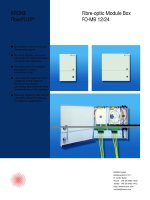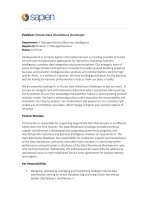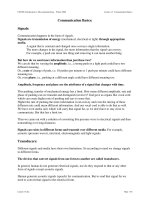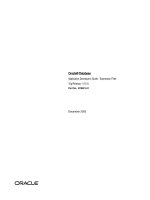Tài liệu Application InterProcess Communication Tutorial pdf
Bạn đang xem bản rút gọn của tài liệu. Xem và tải ngay bản đầy đủ của tài liệu tại đây (127.83 KB, 10 trang )
Application InterProcess Communication
Tutorial
Copyright ©2002-2003 by Peter Sippel Datentechnik
In this Tutorial you will learn how easy it is to link your applications, working together as
one. See here how to use the TAIPC-Classes.
If you have detailed questions about the classes / members, please see the online help.
Create your projects and the project group
Î Please notice, that the whole projects are already created, you don’t have to do this by
yourself. However, this tutorial will help you to get a better start using the components.
First, create a new project and save it as ServerUnit.pas respectively Server,dpr. Then add a
new project to the project Group and save it as ClientUnit.pas and Client.dpr. Create a new
unit csGlobals.pas and add csGlobals to the uses section of both, client and server.
csGlobals.pas
unit Globals;
interface
uses
classes;
type
TStatusMsg = record
status: string[32];
percent: integer;
end;
PStatusMsg = ^TStatusMsg;
TTestBuffer = record
i: integer;
d: double;
s: string[32];
end;
PTestBuffer = ^TTestBuffer;
type
TTestObject = class(TComponent)
private
fd: double;
fi: integer;
fs: string;
public
NotAccessible: integer;
published
property i: integer read fi write fi;
property d: double read fd write fd;
property s: string read fs write fs;
end;
implementation
initialization
RegisterClass(TTestObject);
finalization
UnRegisterClass(TTestObject);
end.
Î Only the published members will be sended to the receiver.
Î We register the class in the initialization and unregister in the finalization section.
The Server project
Now we are going to create the Server program Add the following components to the form:
• A panel, change Align to alLeft, Caption = ‘’ and BevelOuter to bvNone
• A splitter, change the width to 5
• A listview, change ViewStyle to vsReport, ReadOnly to true and create 5 columns:
Handle, Name, Kind, Status, Progress
• 3 checkboxes, set the captions to “Active”, “Ask on Login” and “AllowDupNames”
• 4 buttons, set the captions to “Unlink client”, “Send ClientList”, “Send Testbuffer”
and “SendText”, set enabled to false
• Of course an AIPC Server component, set SessionName to “AIPC Tutorial”
The Server form should now look like this:
Now we add functionality to the server program.
Add the procedure CheckControls to your form:
Î CheckControls is a handy function to set the actuall
state for all controls
procedure TForm1.CheckControls;
var
enable: boolean;
begin
if AIPCServer1.Active
and (ListView1.Items.Count > 0)
and (ListView1.Selected <> nil) then
enable := true
else
enable := false;
btnUnlink.Enabled := enable;
btnSendClientList.Enabled := enable;
btnSendBuffer.Enabled := enable;
btnSendText.Enabled := enable;
end;
Add the function GetItem to your form
Î A small function to get the listitem corresponding to the window handle
function TForm1.GetItem(Handle: integer): integer;
var
i: integer;
s: string;
begin
Result := -1;
s := IntToStr(Handle);
for i:=0 to ListView1.Items.Count - 1 do
begin
if ListView1.Items[i].Caption = s then
begin
Result := i;
exit;
end;
end;
end;
Add the OnCreate Event for the form:
procedure TForm1.FormCreate(Sender: TObject);
begin
CheckControls;
end;
Add the OnChangeEvent for the ListView:
procedure TForm1.ListView1Change(Sender: TObject; Item: TListItem;
Change: TItemChange);
begin
if Change = ctState then
CheckControls;
end;
Add the OnClick Event for the Active Checkbox, AllowDupNames Checkbox and all
buttons:
procedure TForm1.cbActiveClick(Sender: TObject);
begin
AIPCServer1.Active := cbActive.Checked;
if not AIPCServer1.Active then
ListView1.Items.Clear;
CheckControls;
end;
procedure TForm1.cbDupNamesClick(Sender: TObject);
begin
AIPCServer1.AllowDuplicateNames :=
cbDupNames.Checked;
end;
Î The next four functions are corresponding to the selected ListView item
procedure TForm1.btnUnlinkClick(Sender: TObject);
var
hdl: integer;
begin
hdl := StrToInt(ListView1.Selected.Caption);
AIPCServer1.UnlinkClient(hdl);
ListView1.Items.Delete(ListView1.Selected.Index);
end;
procedure TForm1.btnSendClientListClick(Sender: TObject);
var
sl: TStringList;
i: integer;
begin
sl := TStringList.Create;
try
for i:=0 to ListView1.Items.Count-1 do
sl.Add(ListView1.Items[i].SubItems[0];
AIPCServer1.SendIPCMessage(
StrToInt(ListView1.Selected.Caption),sl);
finally
sl.Free;
end;
end;
procedure TForm1.btnSendBufferClick(Sender: TObject);
var
tb: TTestBuffer;
begin
tb.i := 12345;
tb.d := 123.45;
tb.s := 'TESTBUFFER';
AIPCServer1.SendIPCMessage(
StrToInt(ListView1.Selected.Caption), @tb,
sizeof(TTestBuffer),
'ShowTestBuffer','TTestBuffer');
end;
procedure TForm1.btnSendTextClick(Sender: TObject);
begin
AIPCServer1.SendIPCMessage(
StrToInt(ListView1.Selected.Caption), Edit1.Text );
end;
Now the only thing left is to implement the AIPC Server Event Handlers:
Add a new client to the list
procedure TForm1.AIPCServer1ClientLogIn(Sender: TObject;
Client: TAIPCClientItem; var Accept: Boolean);
var
s: string;
item: TListItem;
begin
s := Format('Client %s wants to login' + #13#10 +
'Password is %s' + #13#10 + 'Accept ?',
[Client.Name, Client.Password] );
if cbAsk.Checked
and ( MessageDlg(s, mtWarning, [mbYes,mbNo], 0) = mrNo ) then
begin
Accept := false;
exit;
end;
Accept := true;
item := ListView1.Items.Add;
item.Caption := IntToStr(Client.Handle);
item.SubItems.Add(Client.Name);
item.SubItems.Add(Client.Kind);
item.SubItems.Add('New');
item.SubItems.Add('0');
end;
Remove a client from the list
procedure TForm1.AIPCServer1ClientLogOut(Sender: TObject;
Client: TAIPCClientItem);
var
i: integer;
begin
i := GetItem(Client.Handle);
if i >= 0 then
ListView1.Items.Delete(i);
end;
The Server waits for Status Messages with a TStatusMsg record
procedure TForm1.AIPCServer1IPCBuffer(Sender: TObject; FromHandle: HWND;
Data: PAIPCBuffer);
var
i: integer;
p: PStatusMsg;
begin
if (Data.DataFmt <> 'TStatusMsg')
or (Data.Service <> 'ShowStatus') then
exit;
i := GetItem(FromHandle);
if i >= 0 then
begin
p := PStatusMsg(@Data.Data);
ListView1.Items[i].SubItems[2] := p.status;
ListView1.Items[i].SubItems[3] := IntToStr(p.percent) + '%';
end;
end;
Î Data.DataFmt and Data.Service are informational fields, which can assure properly
processing of the information in Data.Data
Strings and StringLists will be just shown in a message
procedure TForm1.AIPCServer1StringList(Sender: TObject; FromHandle: HWND;
Service: String; Strings: TStrings);
begin
ShowMessage(Strings.Text);
end;
procedure TForm1.AIPCServer1TextMessage(Sender: TObject; FromHandle: HWND;
Service, Msg: String);
begin
ShowMessage(Msg);
end;
The last event is when a component was received
procedure TForm1.AIPCServer1Component(Sender: TObject; FromHandle: HWND;
Service: String; Component: TComponent; var CanDelete: Boolean);
var
tobj: TTestObject;
begin
if Component is TTestObject then
begin
tobj := Component as TTestObject;
ShowMessage( 'Component received !' + #13#10 +
Format('int=%d double=%f string=%s',[tobj.i,tobj.d,tobj.s]) );
end;
canDelete := true;
end;
Î We use the RTTI feature to check and cast the component.
Î Please notice, that canDelete was set to true. This is, because the received component is
not the origonal one that was sended, it’s a copy. Since we don’t need the component
anymore, we let the AIPC object free the component after the event handler.
Î If AIPC can’t create an instance of the sended component, the OnComponentError Event
will be called.
The Client project
Add a panel to the client form and the following components on the panel:
• An edit field for the client name
• A combobox with the client’s kind, items are “Standard”, “Worker”, “Manager” and
“Terminal”
• 3 Checkboxes: “Active”, “Connected” and “Login”. Connected and Login are disabled
• A combobox for the status information, items are “Working”, “Paused” and “Waiting”
• A button to send the status information
• A trackbar to indicate the progress, set Max to 100
• 4 buttons: “Login”, “Send Memo”, “Send Kinds” and “Send TTestObject”
• An AIPC client component. Set SessionName to “AIPC Tutorial” to match the
server’s Session name and ClientName to “TestClient”. The latter is very important in
the Login process, since the server does not accept Clients without a ClientName.
Set the align of the panel to alTop and add a horizontal Slider with the same alignment. Then
add a memo and set the align to alClient.
The client form should now look like this:
Now we add the functionality to the client.
Add the procedure CheckControls to the form:
Î As in the server program, this is a central state checking procedure
procedure TForm2.CheckControls;
begin
cbConnected.Checked := AIPCClient1.Connected;
cbLoggedIn.Checked := AIPCClient1.LoggedIn;
btnSendStatus.Enabled := AIPCClient1.LoggedIn;
btnSendMemo.Enabled := AIPCClient1.LoggedIn;
btnSendKinds.Enabled := AIPCClient1.LoggedIn;
btnSendTestObject.Enabled := AIPCClient1.LoggedIn;
tbPercent.Enabled := AIPCClient1.LoggedIn;
btnLogInOut.Enabled := AIPCClient1.Connected;
if AIPCClient1.LoggedIn then
btnLogInOut.Caption := 'Logout'
else
btnLogInOut.Caption := 'Login';
end;
Call CheckControls within the FormCreate Event
procedure TForm2.FormCreate(Sender: TObject);
begin
CheckControls;
end;
Create Change Events for the Name Edit, the Kind Combobox and Trackbar
procedure TForm2.edtNameChange(Sender: TObject);
begin
AIPCClient1.ClientName := edtName.Text;
end;
procedure TForm2.comboKindChange(Sender: TObject);
begin
AIPCClient1.Kind := comboKind.Text;
end;
Î ClientName and Kind will be send to the server by the next login.
procedure TForm2.tbPercentChange(Sender: TObject);
var
sts: TStatusMsg;
begin
sts.status := comboStatus.Text;
sts.percent := tbPercent.Position;
AIPCClient1.SendIPCMessage(AIPCClient1.ServerHandle,
@sts, sizeof(TStatusMsg), 'ShowStatus', 'TStatusMsg' );
end;
Create the OnClick Event for the Active Checkbox
procedure TForm2.cbActiveClick(Sender: TObject);
begin
AIPCClient1.Active := cbActive.Checked;
if AIPCClient1.Active then
AIPCClient1.CheckConnection;
CheckControls;
end;
Î If the client is activated, we must check the connection to the server in order to set the
appropriate states of the controls.
Create the Login Button OnClick Event
procedure TForm2.btnLogInOutClick(Sender: TObject);
begin
if AIPCClient1.LoggedIn then
AIPCClient1.LogOut
else
AIPCClient1.LogIn('ABC');
end;
Î We use one button for logging in and out
Next, create the OnClick Events for the other buttons
procedure TForm2.btnSendStatusClick(Sender: TObject);
var
sts: TStatusMsg;
begin
sts.status := comboStatus.Text;
sts.percent := tbPercent.Position;
AIPCClient1.SendIPCMessage(AIPCClient1.ServerHandle,
@sts, sizeof(TStatusMsg), 'ShowStatus', 'TStatusMsg' );
end;
procedure TForm2.btnSendMemoClick(Sender: TObject);
begin
AIPCClient1.SendIPCMessage(AIPCClient1.ServerHandle,
Memo1.Lines.Text);
end;
procedure TForm2.btnSendKindsClick(Sender: TObject);
begin
AIPCClient1.SendIPCMessage(AIPCClient1.ServerHandle,
comboKind.Items);
end;
procedure TForm2.btnSendTestObjectClick(Sender: TObject);
var
tobj: TTestObject;
begin
tobj := TTestObject.Create(nil);
try
tobj.i := 9876;
tobj.d := 543.21;
tobj.s := 'Client Object';
AIPCClient1.SendIPCMessage(AIPCClient1.ServerHandle,tobj);
finally
tobj.Free;
end;
end;
Last but not least, the AIPC Client Event Handlers:
Î The only two things we do in the event handlers is to log the event in the memo control
and set the control states with a CheckControls call
procedure TForm2.AIPCClient1ActiveChanged(Sender: TObject);
begin
Memo1.Lines.Add('Active changed to ' +
IntToStr( Integer(AIPCClient1.Active) ) );
CheckControls;
end;
procedure TForm2.AIPCClient1LogInAccepted(Sender: TObject);
begin
Memo1.Lines.Add('Login accepted');
CheckControls;
end;
procedure TForm2.AIPCClient1LogInRefused(Sender: TObject);
begin
Memo1.Lines.Add('Login refused');
CheckControls;
end;
procedure TForm2.AIPCClient1SendTimeOut(Sender: TObject);
begin
Memo1.Lines.Add('TimeOut !');
CheckControls;
end;
procedure TForm2.AIPCClient1ServerAvailable(Sender: TObject);
begin
Memo1.Lines.Add('Server available');
CheckControls;
end;
procedure TForm2.AIPCClient1ServerNotAvailable(Sender: TObject);
begin
Memo1.Lines.Add('Server not available');
CheckControls;
end;
procedure TForm2.AIPCClient1ServerShutDown(Sender: TObject);
begin
Memo1.Lines.Add('Server has shut down');
CheckControls;
end;
procedure TForm2.AIPCClient1ServerStartUp(Sender: TObject);
begin
Memo1.Lines.Add('Server coming up');
CheckControls;
end;
procedure TForm2.AIPCClient1StringList(Sender: TObject; FromHandle: HWND;
Service: String; Strings: TStrings);
begin
Memo1.Lines.Add(Strings.Text);
CheckControls;
end;
procedure TForm2.AIPCClient1TextMessage(Sender: TObject; FromHandle: HWND;
Service, Msg: String);
begin
Memo1.Lines.Add(Msg);
CheckControls;
end;
procedure TForm2.AIPCClient1IPCBuffer(Sender: TObject; FromHandle: HWND;
Data: PAIPCBuffer);
var
pb: PTestBuffer;
begin
pb := PTestBuffer(@Data.Data);
memo1.Lines.Add( 'Integer: ' + IntToStr(pb.i) );
memo1.Lines.Add( 'Float: ' + FloatToStr(pb.d) );
memo1.Lines.Add( 'String: ' + pb.s );
end;
procedure TForm2.AIPCClient1Unlinked(Sender: TObject);
begin
Memo1.Lines.Add('Server has unlinked the login');
CheckControls;
end;
Using the programs
Run the server program and one or more clients.
Play around with the activation checkboxes, status, trackbar, sending buttons and the other
controls to get a feeling of how the programs work together.
Also, run a client before the server or close the server while the clients are logged in.
Then try to add more functionality to the programs like
• Closing the client when server shuts down
• Automatically let the client login when a server is available
• Your own ideas
I hope, you will enjoy the use of the AIPC components.
Peter Sippel









